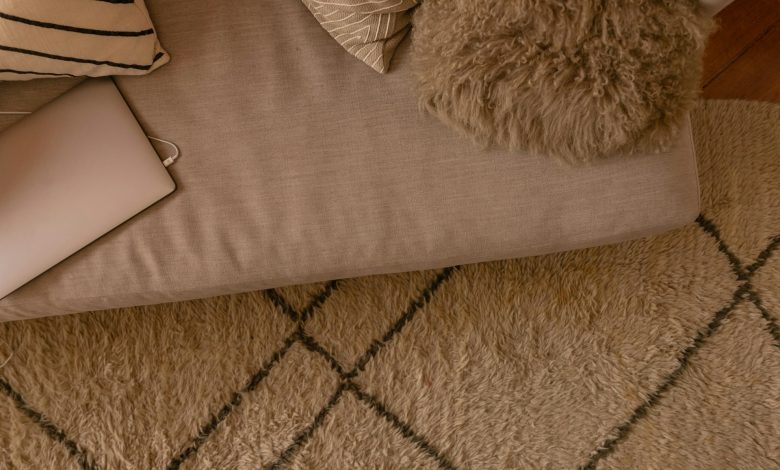
Hallways, lounge rooms, and the patch between the front door and the kitchen usually bear the brunt of daily life. It doesn’t take long for these areas to show signs of wear, like flattened fibres, fading, or that unmistakable track mark where everyone walks.
You can still keep your carpet looking great, without turning your home into a museum no one’s allowed to walk through.
In this guide, we’ll walk you through effective ways to slow the clock on carpet damage in the busiest parts of your home.
Use Area Rugs and Runners
A well-placed protective layer in a hallway or living room can save the carpet underneath from early ageing.
Think of rugs and runners as a buffer zone. They absorb foot traffic, trap dirt, and are far easier to clean or replace than an entire wall-to-wall carpet. Plus, there are styles to suit every home, whether you’re going for modern, coastal, classic, or something in between.
While choosing a rug for a high-traffic area, look for one with a non-slip backing to avoid trips and slips. If it’s machine-washable, that’s even better. It makes clean-up a breeze after a muddy shoe or an enthusiastic pet zoomie.
Additionally, giving your rug the occasional turn helps it wear more evenly, especially in areas where people tend to walk in the same path.
Beyond being practical, rugs also pull the space together visually. They can define zones in open-plan living, add texture and warmth, and cover up an older carpet that’s already showing its age.
It’s a small move, but when done right, layering rugs over carpets offers double the benefit: better longevity and a more polished, lived-in look.
Implement a Regular Cleaning Schedule
Even the toughest carpet won’t survive long if it’s left to collect grit and grime. Dust, dirt, and soil may seem harmless, but underfoot, they act like sandpaper, wearing down your carpet with every step.
Vacuuming is your first line of defence. In busy areas, going over your flooring a few times a week is ideal. Use a hoover with strong suction and a rotating brush head. It’ll reach deeper into the fibres, rather than just skimming the surface.
Every six months to a year, make time for a proper deep clean. Carpet steam cleaning is a reliable method, especially if your home sees a lot of activity.
Whether you go the DIY route with a hire machine or book in a professional cleaning service, make sure the products used are suitable for your flooring.
Also, don’t be too patient with spills. The quicker you address them, the better the outcome. Remember to blot and never scrub, and choose cleaners that match both the stain and the fabric.
Finally, regularity doesn’t have to mean rigidity. Even a seasonal calendar reminder can go a long way toward keeping your carpet fresh, vibrant, and in top condition.
Rotate Furniture Occasionally
Most households end up with fixed pathways and worn spots around the same layouts, year in and year out.
That constant pressure in the same areas can take a real toll on your carpet. It leads to uneven wear, crushed pile, and those familiar dents where the couch has claimed permanent residency.
Every few months, it’s worth giving your room a light shuffle. You don’t need to move everything around, but even small changes in furniture placement can spread out foot traffic and give tired areas a break.
It’s a little effort that can make a difference to the look and feel of your carpet, especially in lounge rooms and bedrooms where heavy pieces tend to stay put.
There’s also a nice bonus to rearranging furniture from time to time: it freshens up the space. A new layout can make a room feel bigger, brighter, or just a little more interesting. And your carpet? It’ll look better for longer, without any extra cost.
Use Underlay and Furniture Pads
A good-quality underlay acts as a cushion between your carpet and the subfloor, absorbing pressure, reducing friction, and helping your carpet keep its shape under constant use.
In high-traffic areas, a sturdy underlay isn’t optional—it’s essential. Look for materials like dense foam or rubber, which provide long-lasting support without flattening out too quickly.
They also help with insulation and noise reduction, which is a nice bonus if you have floorboards underneath or a second storey above.
Heavy items like lounges, bookshelves, and beds tend to leave behind deep dents, especially if they’ve been in place for years.
To avoid this, fit protective pads or coasters under the legs. If you want extra security in busy spots, clear plastic mats or corner guards can offer protection without ruining the look of your space.
Limit Direct Sunlight Exposure
Sunlight makes a room feel bright and welcoming, but too much direct light can damage carpets over time. UV rays can bleach fibres, causing uneven fading and a washed-out look that cleaning won’t fix.
If your carpet gets a lot of sun through the windows in the morning, install blinds, curtains, or shutters to filter the light during peak hours. Even sheer curtains can take the edge off those harsh midday rays without darkening the whole room.
For an extra layer of protection, UV-blocking window film is a smart addition. It’s virtually invisible but helps shield your carpet from long-term damage, all without losing that bright, open feel.
If you have rugs on top of your carpets, rotate them every few months to prevent uneven fading. This is especially helpful in spots where sunlight hits one side more than the other.
In short, sunlight is lovely, but moderation is key. A little shade here and there goes a long way in helping your carpet stay vibrant and even-toned for years to come.
Choose the Right Carpet Material
While protecting your existing carpet goes a long way, sometimes you’ll eventually need to think about replacement. Choosing the right carpet from the start can make all the difference in high-traffic areas.
Durable fibres like nylon and polyester stand up well to daily foot traffic, resist fading, and bounce back from heavy use better than plush, deep-pile options.
Shorter, denser piles also handle wear more gracefully and are easier to clean, saving you time and effort in the long run.
Even small decisions—like picking the right fibre or pile—can stretch your carpet’s lifespan and keep your home looking fresh, no matter how busy it gets.
Conclusion
No matter how durable something claims to be, constant wear takes its toll.
That’s why we protect the things we rely on. We put cases on phones, polish our shoes, and tint our windows. A bit of shielding makes all the difference. It slows the damage and spreads the impact. The same logic applies to your flooring.
So if you’re hoping to avoid threadbare paths and early replacements, don’t wait until the damage is done. Give your carpet the protection it deserves.



